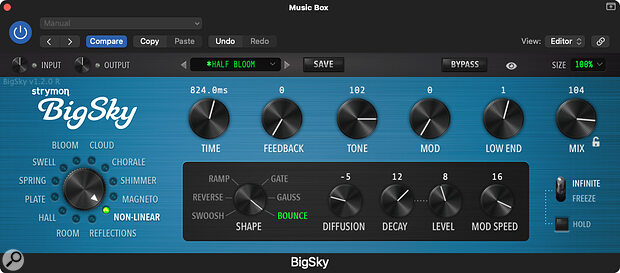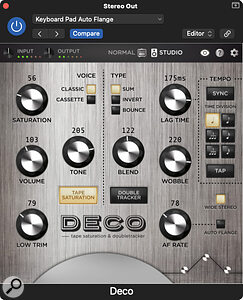 The BigSky plug‑in makes accessing secondary functions even easier than on the hardware pedal.
The BigSky plug‑in makes accessing secondary functions even easier than on the hardware pedal.
Strymon’s reputation for making top‑quality digital effects pedals is second to none, but recently they’ve also made some of their creations available as DAW plug‑ins. The first two to market are BigSky and Deco — the former is a multi‑engine reverb, and the latter offers tape saturation and a double‑tracking effect. They both use code that’s ported directly from Strymon’s hardware pedals, so you know you’re getting the real thing, and while Strymon went to great lengths to ensure the pedals’ user interfaces were as intuitive as possible, they’ve managed to make operation even more straightforward in the plug‑ins.
All the common plug‑in formats, including AAX, are supported across macOS (11.6.4 and higher) and Windows (10 and up), with authorisation via an iLok account (no physical dongle required). By the way, if you’re unfamiliar with the hardware versions, it would be well worth checking our January 2014 review of the BigSky (https://sosm.ag/0114-strymon-big-sky) and our Deco review, which appeared in SOS October 2015 (https://sosm.ag/1015-strymon-deco), both of which are free to view.
Taking BigSky first, as with the hardware, this plug‑in offers a choice of 12 algorithms that cover familiar themes, such as real spaces, plates, springs and reflections, as well as more creative takes on reverb such as Non‑linear, Cloud, Swell, Shimmer, Magneto (a multi‑head tape echo with added diffusion) and Bloom. The main controls govern algorithm selection, decay, pre‑delay, tone, modulation, low end and mix, with a Hold switch that can engage either a freeze or an infinite reverb mode. Smaller controls at the top left of the GUI adjust the overall input and output levels, and there’s a generous collection of presets to get you started (you can, of course, save your own settings too). You can opt to see control values or not by clicking the eye icon.
Switch algorithms, and the lower part of the GUI also changes. For example, run the Reflections algorithm and there’s a small overhead view of the room with a draggable sound source cursor, while in Chorale mode you can select from a number of vowel filters and resonance options. If you adjust these algorithm‑specific controls during a session, their settings persist if you switch to a different algorithm and back. Note that some of the main controls also take on a slightly different function depending on the algorithm. For example, in the Bloom algorithm the tone control becomes a resonant filter and the modulation control is reconfigured specifically for this algorithm.
 The Deco plug‑in is all about tape echo, flanging and double tracking, but you can also use it just for the tape emulation.
The Deco plug‑in is all about tape echo, flanging and double tracking, but you can also use it just for the tape emulation.
Moving on to the Deco plug-in, this emulates the sound of analogue tape to produce effects such as echo and flanging, though it’s also possible to use just the tape saturation emulation to give tracks that ‘recorded to tape’ vibe. There’s a choice between open reel and cassette emulation, the latter replicating the original ALC auto‑limiting circuit found in high‑end 1970s cassette decks. There are knobs to control Saturation, Volume, Tone, Low Trim, Blend, Wobble, Auto‑Flange Rate and Lag Time, plus a small number of buttons.
Flanging and ADT effects were originally created by using two tape machines carrying copies of the same material, and Deco follows this approach to recreate these vintage techniques. It is the time relationship between the two tape machines that creates effects such as phasing, through‑zero flanging, chorus, echo and automatic double tracking. The effects can be free‑running or tempo‑sync’ed, with an Auto Flange option that recreates a smooth, through‑zero flange without the user needing to physically adjust or automate the Lag Time control.
The virtual ‘reference’ tape machine is the one on the left while the one on the right, the Lag deck, can be polarity‑inverted, delayed and modulated with respect to the reference. When working in stereo, Bounce mode causes the right channel of the Lag deck to be polarity‑inverted and bounced to the left channel input, resulting in a ping‑pong type effect. I can confirm that Deco recreates vintage tape flanging and ‘John Lennon’ ADT extremely convincingly, and it can also create conventional tape delays of up to 500ms.
Both these Strymon plug‑ins are seriously good, and BigSky in particular can add magic to pretty much any instrument or voice.
Both these Strymon plug‑ins are seriously good, and BigSky in particular can add magic to pretty much any instrument or voice, not just guitar. Having these effects available as plug‑ins can be beneficial even if you own the hardware versions: you can use multiple instances in a project, it’s easier and more effective applying the effects to tracks after your recordings have been edited, and you can automate parameters without having to set up MIDI control. Meanwhile the pedals are easier to plumb into a guitar/pedalboard rig, and will work better on stage.
There are free seven‑day trials available for both plug‑ins... but don’t be surprised if at the end of that period you feel you simply have to own them!

